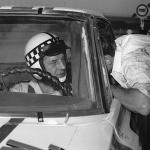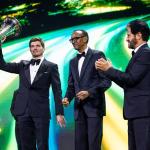There will likely be recent blood aplenty in Free Apply 1 classes this Method 1 season, with groups required to run rookies twice in every of their vehicles (or entries, to be exact).
To be frank, a rookie’s FP1 outing is often not the headliner of an F1 grand prix. Groups typically go away it till the final second to tick that field, leaving younger drivers with what are successfully essentially the most ‘perfunctory’ classes of the 12 months: one thing like FP1 in Abu Dhabi, in circumstances properly indifferent from these of the particular grand prix, or in Canada, on a avenue monitor with oft-suboptimal climate.
These rookie outings not often embody efficiency runs, with engineers preferring to steer younger drivers away from any duties that carry excessive injury dangers. Which, as Andrea Kimi Antonelli’s outing in Monza confirmed final 12 months, is not the worst thought, given how motivated children are to catch the attention.
Because of this, rookie drivers are sometimes delegated with aero rake working, which can typically include an instruction to keep away from the kerbs in any respect value and keep beneath a sure pace on the straights.
Regardless of all this, the architects of the rule have sufficient proof to deem it successful already. Take Franco Colapinto for instance – James Vowles has repeatedly acknowledged that it was the Argentine’s efficiency throughout first apply at Silverstone that had given him the boldness to advertise the teen right into a race seat. With out the rule in place, there’s good purpose to imagine it could have been Mick Schumacher, not Colapinto, getting into the Williams.
And whereas Oliver Bearman might have introduced himself to the surface world in Saudi Arabia, he’d crucially impressed his present crew boss Ayao Komatsu about half a 12 months prior, when he’d carried out an ideal, mistake-free FP1 programme on a dusty monitor in Mexico. His Jeddah heroics wanted solely to strengthen Komatsu’s already held view of Bearman – and even a troubled F2 marketing campaign wasn’t a significant impediment to the Briton’s 2025 Haas contract.
Ayao Komatsu and Oliver Bearman
Photograph by: Zak Mauger / Motorsport Pictures
Whereas the rookie rule could also be a burden for some groups – usually they’d naturally favor to maximise their race drivers’ time behind the wheel – it does work. There’s a case to be made that it is a important issue behind a virtually one-third refresh of the F1 grid this 12 months.
Rookie move
It is value remembering that not each crew must sideline considered one of its regulars on all 4 events this 12 months, as some common race drivers qualify as rookies. As per the foundations, rookies are these with “no more than two championship races of their profession”. So the likes of Antonelli, Gabriel Bortoleto and Isack Hadjar will not should cede their vehicles to anybody – they may maintain the standing till the Bahrain Grand Prix, so will tick off their automobile’s two rookie FP1s in Australia and China.
The identical is true for Jack Doohan, regardless that he already raced in Abu Dhabi final 12 months. His rookie standing will expire after the Chinese language Grand Prix – however the first two FP1 classes will nonetheless happen earlier than that, fulfilling the requirement.┬ĀBecause of this, solely their team-mates – Pierre Gasly, George Russell, Yuki Tsunoda and Nico Hulkenberg – must quit their vehicles through the season.
Learn Additionally:
One other related element is that F1 has retained the ‘Free Apply Tremendous Licence’ rule, widening the scope of drivers eligible to take part past the present pool of superlicence holders.
A practice-only licence requires simply 25 factors slightly than 40 – although a earlier 300km in an F1 automobile is required, for example by way of a crew’s TPC (Testing of Earlier Automobiles) programme.
Who will drive for the highest groups?
Rookie FP1s are most related for these groups with extremely regarded prospects, and Pink Bull virtually all the time falls in that class. It is easy to think about that Christian Horner and Helmut Marko will need to consider Arvid Lindblad as a lot as potential, now that he has already amassed the requisite superlicence factors and on condition that, with a profitable F2 season, he may properly find yourself on the grid in 2026┬ĀŌĆō if not earlier. Good FP1 outings would assist fast-track him – and a runout within the spring could possibly be logical. On the similar time, Pink Bull additionally has two different doubtlessly related juniors in F2, Oliver Goethe and Pepe Marti.

Arvid Lindblad
Photograph by: Pink Bull Content material Pool
On Ferrari’s finish, the success of the Bearman experiment means, mockingly, that there is no apparent candidate this time. You’d count on Arthur Leclerc, Charles’s brother, to get one other apply outing or two, nevertheless it seems to be as if Ferrari Driver Academy’s Dino Beganovic is being readied as subsequent in line, having already secured 40 superlicence factors. The crew ran him in its non-public Bracelona check earlier this 12 months, although it stored largely quiet about it.
Antonelli’s promotion means rookie classes are much less apparent to fill for Mercedes once more – particularly as its new reserve driver Valtteri Bottas exceeds the rookie criterion by 250 begins or so. Frederik Vesti will most likely get the nod.
McLaren is in an identical scenario. Final 12 months, IndyCar driver Pato O’Ward popped up in apply – as did Ryo Hirakawa, whose outing in Abu Dhabi was a shock to many. Hirakawa is not an possibility, having aligned with Alpine as an alternative, whereas O’Ward will certainly get one other session or two. There’s additionally certainly a chance McLaren would need to see what it is acquired in junior Ugo Ugochukwu, whose win in Macau final 12 months pushed him previous the required factors threshold.
What about the remaining?
Aston Martin is probably going to offer all 4 of its rookie apply outings to Felipe Drugovich, who’s re-signed because the crew’s reserve driver.
Alpine will not have an excessive amount of of a problem discovering an applicable candidate both. Along with the aforementioned Hirakawa, it now has Paul Aron on its books┬ĀŌĆō and already ran him within the post-season younger driver check final 12 months.
Racing Bulls solely must test off two classes, because of Hadjar’s promotion. Lindblad will probably be within the automobile, whereas – given the continued relationship with Honda – there’d be logic in deploying Ayumu Iwasa in Japan once more, because the crew did final 12 months.
Learn Additionally:
There’s significantly much less readability in regards to the three remaining groups.

Ritomo Miyata
Photograph by: Eric Le Galliot
At Haas you’d definitely count on Toyota protege Ritomo Miyata to drive, given he already had a TPC outing at Jerez in January and has the requisite licence factors by way of his titles in Japan. Additionally within the image right here is Pietro Fittipaldi, who stays a rookie by regulation regardless of his two begins in 2020 – although his function at Haas for 2025 is not confirmed because it stands. Oliver Bearman, because of his three stand-in begins final 12 months, not fulfills the quota.
Luke Browning is best-positioned to get some extra FP1 classes at Williams, particularly given it is a post-Colapinto Williams that has additionally break up with one other junior in Zak O’Sullivan.
At Sauber it seems to be like a clear slate. Lengthy-time protege┬ĀTheo Pourchaire has been launched, however final 12 months he was already watching from the sidelines as Robert Shwartzman, extremely rated by Mattia Binotto, drove the automobile as an alternative. The Russian-Israeli driver, nonetheless, is now beginning his new racing life within the US as an IndyCar driver, so a shock exterior candidate would make sense right here.
On this article
Oleg Karpov
Method 1
Ryo Hirakawa
Frederik Vesti
Arthur Leclerc
Paul Aron
Dino Beganovic
Arvid Lindblad
Be the primary to know and subscribe for real-time information electronic mail updates on these subjects
Subscribe to information alerts










